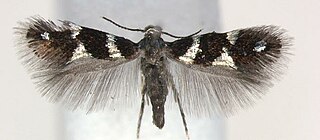
The Heliozelidae, commonly known as shield-bearer moths, are a family of small, day flying monotrysian moths distributed worldwide. The larvae of most heliozelid species are leaf miners who cut distinctive shield-shaped cases from the surface of the host leaf, hence the common name. Some species are considered pests of commercial crops such as grapevines, cranberries, and walnuts. The taxonomy of this family is poorly understood.
Atralata is a genus of moths of the family Crambidae. It contains only one species, Atralata albofascialis, which is found in most of Europe, except Ireland, Great Britain, Norway, Finland, Lithuania and Greece.
Parornix carpinella is a moth of the family Gracillariidae. It is found from Sweden to the Pyrenees, Italy and Greece and from Great Britain to Russia.

Coleophora granulatella is a moth of the family Coleophoridae. It is known from most of Europe to China. It was recently reported from North America, with records from Alberta, British Columbia, Yukon, Arizona, Colorado, Michigan, Wyoming and Washington.

Dichomeris heriguronis, the black-edged dichomeris or black-edged carbatina, is a moth of the family Gelechiidae. It is found in the north-eastern United States, Korea, Japan, China, Taiwan and India. It has also been recorded in the Netherlands, where it is an exotic species.

Elachista albifrontella is a moth of the family Elachistidae found in Europe.

Antispila treitschkiella is a species of moth of the family Heliozelidae. It is found from Great Britain to Ukraine and from Sweden to France, Italy and Greece. It is also found in Portugal.

Gymnancyla is a genus of snout moths. It was described by Philipp Christoph Zeller in 1848.

Dichelia histrionana is a species of moth of the family Tortricidae. It is found from Fennoscandia to Belgium, Italy and Greece and from the Netherlands to Poland and Romania.

Epiblema sticticana is a species of moth of the family Tortricidae described by Philogène Auguste Joseph Duponchel in 1842.

Depressaria albipunctella is a moth of the family Depressariidae. It is found in most of Europe, as well as in Libya.

Depressaria pulcherrimella is a moth of the family Depressariidae. It is found in most of Europe, except the Balkan Peninsula.

Bucculatrix demaryella is a moth of the family Bucculatricidae. The species was first described by Philogène Auguste Joseph Duponchel in 1840. It is found in most of Europe, Russia and Japan.

Acrobasis advenella is a species of snout moth in the genus Acrobasis. It was described by Johann Zincken in 1818 and is found in most of Europe.

Ephestia unicolorella is a species of snout moth in the genus Ephestia. It was first described by Staudinger in 1881, and is known from Iran, Turkey, Morocco, Azerbaijan and most of Europe.

Epischnia prodromella is a species of snout moth in the genus Epischnia. It was described by Jacob Hübner in 1799, and is known from North Africa and most of Europe, except Fennoscandia, Ireland, Great Britain and the Baltic region.

Delplanqueia dilutella is a species of moth in the family Pyralidae. It was described by Michael Denis and Ignaz Schiffermüller in 1775. It is found in most of Europe, east to Russia, Turkey, Iran and Mongolia.

Hypochalcia ahenella is a species of snout moth in the genus Hypochalcia. It was described by Michael Denis and Ignaz Schiffermüller in 1775 and is known from most of Europe, Turkey, and Texas in the US.

Ochsenheimeria vacculella, the cereal stem moth, is a moth of the family Ypsolophidae. It is found in most of Europe, except Ireland, Norway, Portugal, Italy and most of the Balkan Peninsula. The species was accidentally introduced into parts of the United States.

Dichrorampha alpinana, the broad-blotch drill, is a species of moth of the family Tortricidae. It is found in almost all of Europe.
















